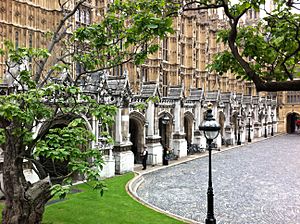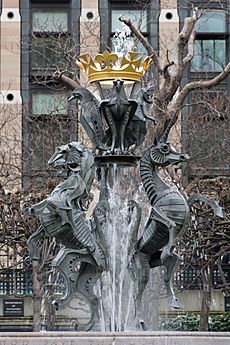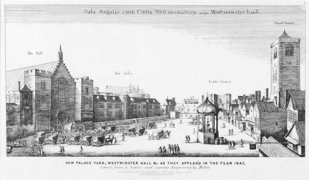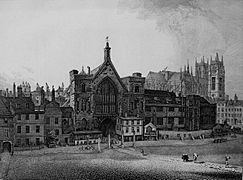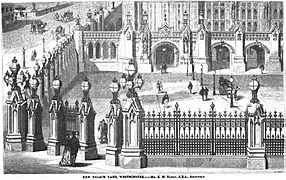New Palace Yard facts for kids
Quick facts for kids New Palace Yard |
|
|---|---|
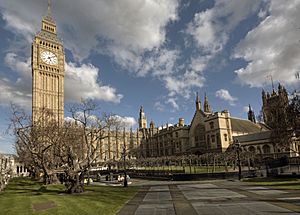
View of New Palace Yard in 2017, looking south-east
|
|
| Type | Open courtyard |
| Location | Westminster, London, England |
| Area | Palace of Westminster |
| Built | circa 1100 |
| Governing body | Parliament of the United Kingdom |
| Lua error in Module:Location_map at line 420: attempt to index field 'wikibase' (a nil value). | |
New Palace Yard is an important open space in Westminster, London, England. It's located just northwest of the famous Palace of Westminster, where the UK Parliament meets. While it's a private area, you can still see it from the nearby streets. This is because Edward Middleton Barry, who helped design the area, chose to use railings instead of solid walls.
This yard has been around since about the year 1100. It used to be much larger but was made smaller in the 1700s. This allowed new streets and buildings to be built. One of the most famous buildings added was the part of the Palace that includes the well-known Elizabeth Tower (often called Big Ben). There's also an underground car park beneath the yard, used by Members of Parliament. In the past, New Palace Yard was a busy public space. People gathered there for speeches, exciting tournaments, and even public punishments.
Contents
Where is New Palace Yard?
New Palace Yard is in the northwest corner of the Palace of Westminster grounds. It has Bridge Street to its north and the Palace's North Front, including Big Ben, to its east. To the south, you'll find Westminster Hall, and to the west is Parliament Square.
You can enter the yard from Parliament Square through the Carriage Gates. Below the yard is a large underground car park. It has five levels and 450 spaces for the cars of Members of Parliament. This car park was built in the 1970s. The north end of Westminster Hall can be reached through the yard. This is also where Members of Parliament enter the House of Commons.
There's a public walkway along the Westminster Bridge side of Speaker's Green. This path goes under Bridge Street. It connects Westminster tube station and Westminster Pier, which are both located under the Victoria Embankment.
What Does New Palace Yard Look Like?
The yard is designed like a beautiful garden. It has a formal path lined with lime trees and benches made of Portland stone. In the center, there's a lawn surrounded by an oval road. Around the edges of the yard, you can see several old catalpa trees.
A special fountain was placed in the central lawn in 1977. This was to celebrate the Silver Jubilee of Elizabeth II, marking 25 years of Queen Elizabeth II's reign. The fountain reminds people of an old medieval fountain that used to be there, built by King Henry VI.
The fountain stands in an eight-sided pool. In the middle of the pool is a large sculpture made of welded steel by Walenty Pytel. This sculpture is decorated with images of birds and animals from six different continents. On top of the sculpture is a shining golden crown.
A Look Back in Time: History of the Yard
The name "New Palace Yard" refers to the very first Palace of Westminster. This palace was built by the Anglo-Saxon king Edward the Confessor around the year 1050. The yard itself was created after King William II built Westminster Hall in 1097. It was called "New" to tell it apart from Old Palace Yard, which is a bit further south.
For many centuries, this area was likely a low, wet, marshy piece of land. It was even prone to flooding until more recent times. In the 1100s, the River Thames rose quickly. This made it necessary to build a river wall on the eastern side of the yard. The land was then built up with layers of stones and debris. By the late 1200s or early 1300s, it was laid out as an open space. As Westminster grew, the yard became surrounded by buildings and walls.
New Palace Yard played a similar role to an outer courtyard in a castle. It was one of three main yards in the palace. New Palace Yard was the outer area, a large open space where ordinary people could go. The Green Yard was the middle area, where the king's government offices were located. Old Palace Yard was the inner area, where the royal family lived.
For centuries, a large fountain with a dome on top stood in the middle of the yard. King Henry VI built this fountain in 1443, and it remained there until the late 1600s. According to a historian named John Stow, this fountain, known as the Great Conduit, would flow with wine during coronations and other big state events. The remains of this old fountain were found again in the 1970s when the underground car park was being built.
New Palace Yard was also a place for public punishments. People who broke the rules were sometimes put in a pillory there. For example, Perkin Warbeck, who pretended to be a prince, was put in the pillory in 1498. Titus Oates was also punished there during the time of King James II. The last person to be put in the pillory in the yard was John Williams in 1765.
Exciting tournaments and royal parties also took place here. In 1501, when Catherine of Aragon married Arthur, Prince of Wales, a huge tournament was held in New Palace Yard. A special stand was built for the King on the south side. Challengers would ride out of Westminster Hall on horseback. They were joined by a special parade float pulled by four animals, carrying a "fair young lady" on a beautiful golden chair. The last time jousting was recorded in the yard was in 1547, when Edward VI became king.
How New Palace Yard Changed Over Time
New Palace Yard was originally much bigger than it is now. A drawing from 1647 by Wenceslaus Hollar shows it as an enclosed rectangle. There were houses on both sides of Westminster Hall, and Henry VI's fountain was in the center. The drawing also shows a row of shops, taverns, and coffee-houses on the north side. On the west side, there was a large square gatehouse that led to King Street. This gatehouse was built by King Richard III and stood until 1707. A tower on the north side, built under King Edward I, was taken down in 1715. It held a bell known as Great Tom.
Many buildings around New Palace Yard were removed in the 1750s. This happened during a big city redesign that came with the building of Westminster Bridge. Bridge Street was built to the north of the yard. Parliament Street was created to connect the Palace with Charing Cross, and Abingdon Street connected it with Millbank. A row of buildings separated the yard from Bridge Street until they were taken down in 1866–67. This opened up the yard so people could see it from the street.
In the 1700s and 1800s, coffeehouses and taverns were common around New Palace Yard. It was a place for public gatherings, like a rally in September 1838 to support the People's Charter of 1838. Public access to New Palace Yard became limited after 1866. This was after a protest in Hyde Park for parliamentary reform became violent. Edward Middleton Barry was asked to enclose the yard with railings about 7 feet (2.1 meters) high. These were finished by February 1868. These changes meant the ground level of the yard was lowered by as much as 3 meters (10 feet) in some places.
The yard was sometimes opened to the public for speeches by important figures like William Ewart Gladstone. However, it is now a secure area and is closed to the public.
Between 1972 and 1974, an underground car park was built beneath the yard. It has 450 spaces and cost about £2.5 million at the time.
Important Events at New Palace Yard
New Palace Yard has been the site of two serious incidents. On March 31, 1979, a car bomb exploded. It killed Airey Neave, a Member of Parliament, as he was leaving the underground car park at New Palace Yard.
Later, on March 22, 2017, another tragic event occurred. A person drove a car into people on Westminster Bridge. Then, they crashed the car into the fence of the Palace grounds. After leaving the car, they ran into New Palace Yard and attacked PC Keith Palmer, an unarmed police officer guarding the Carriage Gates. Other armed police officers then stopped the attacker, who later died at the scene.
See also
- Old Palace Yard


